Getting around Italy by Train
By Alan Zisman © 2018-09-20; updated 2024-09-06
We love Italy and go there whenever we can - though it's more of a ordeal getting there from the West Coast of Canada than, say, the UK. We just got back from our 10th trip this week (as of September 2018 - as of 2023 we're up to 13 trips). Much to the surprise of some folks we know, though, we've never rented a car - when we're there, we get around on foot much of the time, and when that won't work, we go by train.
The Italian train system goes to all the big and medium-sized cities and lots of the small towns. (Not all of them - once in a while we have to take a bus. But not usually). And train service is reasonably comfortable, reasonably quick, and reasonably inexpensive - about half the cost of comparable British service, for instance.
There are some quirks - magnified by language, though the Italian train system tries to offer its services in English alongside Italian.
A few things to know to get started - most of the trains are part of a nationalized country-wide network run by Gruppo Ferrovie dello Stato Italiane under the name Trenitalia. There is some competition from Italo - but they only operate between major cities. There are some local, independent rail lines, like the Circumversuviana line that goes between Naples and Sorrento, with stops including Pompei. But most of the time, you'll be dealing with Trenitalia - and that's what I'm going to focus on.
New 2023-10-12: Trenitalia offers foreigners a Trenitalia Pass - allowing for multiple train tips within a period of time. 4 options range from 3-4 journeys within 7 days, 7 journeys within 15 days, 10 journeys within 30 days and prices starting at €129. This may be a good deal for you - personally, it seems like a lot of train travel - more or less a long train ride every second day. If you are planning to stay in a home base (or several home bases) with perhaps shorter day-trips, it would probably be less expensive to book the long train rides ahead of time and then be spontaneous about your shorter, regional day-trips.
Trenitalia offers three levels of trains: Regionale trains are the local trains - they run, mostly within a single region, as the name suggests - stopping at many small stations along the way. Slowest, due to the frequent stops, but also the least expensive option. No reserved seats. You can sometimes buy first class or second class tickets - first class has 3 seats in a row, second class has 4 seats in a row, but otherwise there's not much difference. (Not all trains have first class seating available). Sometimes we've found first-class tickets going for not much more than 2nd class - but usually we travel 2nd class.
Intercity trains make fewer stops at small stations - making for a faster run at a higher price. Often, tickets include assigned seating on these trains - so make sure you sit in the assigned seats.
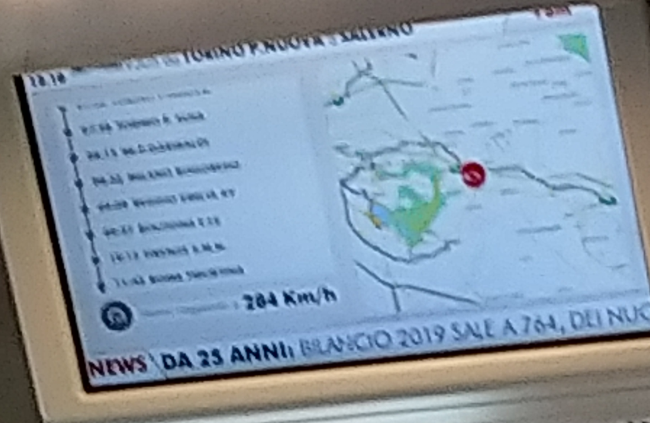 'Freccia'
trains (Italian for 'arrow') offer the fastest service - only available
between major cities. You pay extra for the extra speed (up to 400 km/hr!). For instance,
you can travel from downtown Rome to Venice in 3 hours and 45 minutes
on a Frecciargento ('Silver Arrow') or Frecciarossa ('Red Arrow') for
€50-75. Or spend 6 hours on an Intercity train for €57. Or you could take 11 hours (including 2 changes) on a series of
Regionale trains for €42. I know which I would choose!
'Freccia'
trains (Italian for 'arrow') offer the fastest service - only available
between major cities. You pay extra for the extra speed (up to 400 km/hr!). For instance,
you can travel from downtown Rome to Venice in 3 hours and 45 minutes
on a Frecciargento ('Silver Arrow') or Frecciarossa ('Red Arrow') for
€50-75. Or spend 6 hours on an Intercity train for €57. Or you could take 11 hours (including 2 changes) on a series of
Regionale trains for €42. I know which I would choose!
I find Trenitalia's online scheduling information very useful and refer to it often - both before travelling and while I'm in Italy. It lets me know if there is train service where I'd like to go - and if so, how often it runs. If there are a couple of trains each hour, then I can be pretty flexible in my planning. If there's just one train in the afternoon and one in the evening, though, I want to make sure I get to the station on time!
Note- prices on Intercity and Frecce trains will be more expansive getting tickets for that day compared to booking well in advance. For instance, I had looked at train options from Tivoli to Salerno several months prior to our trip - the train we thought we might take was listed as costing 26 Euro. We didn't get tickets - our plans were not yet finalized. Arriving in the station the day we wanted to travel, the same trip cost is double - 52 Euro... Similarly, a train from Lecce to Ancona jumped from 35 Euro well in advance to 70 Euro a few days prior to departure. Ancona to Perugia price jumped from 11.55 Euro to 34.65 Euro (tripling!) two days prior to departure. More on when to book for the best price below.
Short (regional) tickets, however, are the same price in advance or on the day - so no need to book ahead of time.
My advice - buy your long haul fast train tickets at least 3 weeks in advance online for the best prices, but let yourself be spontaneous with local day trips - no need to overplan these. If that's not practical, booking those trips in advance - even a day in advance - will still bring significant savings in price.
But - when I was online looking at the recently tripled Ancona-Perugia tix two days prior to departure, and clicked on a departure time, I noticed a 'View other offers' button. Clicking that offered me the same tickets for the old price! (This was available using my laptop and on my phone, where the equivalent button said 'More offers'). Needless to say, I bought those tickets! This won't always work (it didn't on my fantasy Milan-Turin experiment) but be sure to check if you're buying a ticket on a fast train leaving in the next couple of days.
More: When To Buy Train Tickets In Italy To Get The Best Deal: https://www.explore.com/1559781/when-buy-train-tickets-italy-get-best-deal/
Trenitalia's website is available in English: https://ca.trenitalia.it-inter.com/ - you can customize it for your country, prefered currency, and language. New feature (Sept 2018) - you can now enter Italian city names with your choice of the English language name or the Italian name: Rome vs Roma, Florence vs Firenze, Venice vs Venezia, etc. Previously, even if you were using the English language version of the website, you needed to know and use the Italian version of city names.
(The older English language page: https://www.trenitalia.com/en.html is still online and may work more efficiently - but requires you to use Italian-language city names - Roma, Genova, Milano, etc). The illustrations below were captured on the new page.
Both Trenitalia and ItaliaRail have smartphone apps that can used to purchase tickets - delivered digitally right to your phones. However, I was unable to install the Trenitalia Android app from outside Italy - I'll try to get it when I'm back in Italy!
I
don't want to actually buy my tickets right now - I was just checking
online to see what was available. It looks like a lot of ways to get
from Genova-Brignole to Levanto, throughout the day. Several trains
each hour - for a trip that takes more or less an hour.
Some things can be misleading, however. I checked whether there were train connections from Salerno to Matera and saw:

Looks like there are two options, right? But a couple of things that may not be immediately obvious - the 'Trains' are listed as 'Freccialink' which refers to buses going to or from places lacking train service. And there's no price listed - in fact, despite showing these options on their website (and on ticket machines at a station), this service seems to be imaginery - which would be unfortunate if you planned a trip assuming the service existed, as I did! (Luckily, the German bus company Flixbus, provided connections, though it dropped us off in Matera at an out-of-the way location - affordable tickets to and from many European locations).
So when I get to Genova Brignole, I'm going to wander over to one of the Trenitalia ticket machines scattered around the lobby of the station. Note that you may see a mix of Trenitalia ticket machines and machines from the alternative ItaliaRail company ('Italo'). Pick the one you want - though remember that Italo only services major cities, so it won't get me from Genoa to Levanto.
They feature touch screens - and the first screen includes a set of small flag icons along the bottom of the screen to change the language from Italian. Tap a finger on the UK flag icon to change the language to English. When you do that, you'll get a new screen - with a voice in delightfully Italian-accented English warning you to 'Beware of Pickpockets' - thus letting everyone in the station know that an English-speaking tourist is in their midst.
(Do take pickpockets seriously! Crowded, busy train stations can be places frequented by pickpockets. See, for instance: Train Scams and Pickpockets – What to watch out for)
The ticket machines work similarly to the website, but with an older version of the software that doesn't let you use the English versions of Italian city names. You have to use Genova, Roma, Firenze, Venezia, Milano, etc.
In larger stations, if you prefer, you can get your tickets the old fashioned way - from a ticket agent at a counter. But you'll probably have to wait in line and deal with someone who's English is only a bit better than your Italian. And many smaller stations have no ticket office - you'll just have to deal with a ticket machine.
Important to note - Because this is on an Intercity train, there is
assigned seating. 'Carrozza' indicates the number of the carriage
(marked on the train door): Carrozza 006. 'Posto/Posti' is the seat: 63
Corridoio (aisle - Finestrino indicates a window seat).
If your proposed trip requires that you change trains, you will get separate tickets for each leg of the trip. For instance, in 2017, we went from Varenna (on Lake Como) to Venice - we had to change trains in Milan. So the machine at the small station in Varenna printed out two tickets - one for the Varenna-Milan train, the second for Milan-Venice. The second ticket included reserved seats. Note that you'll have to exit the first train, figure out the binario (track #) for the second train, and haul your luggage there, in some cases pretty quickly!
Here's a smaller ticket for a different trip:
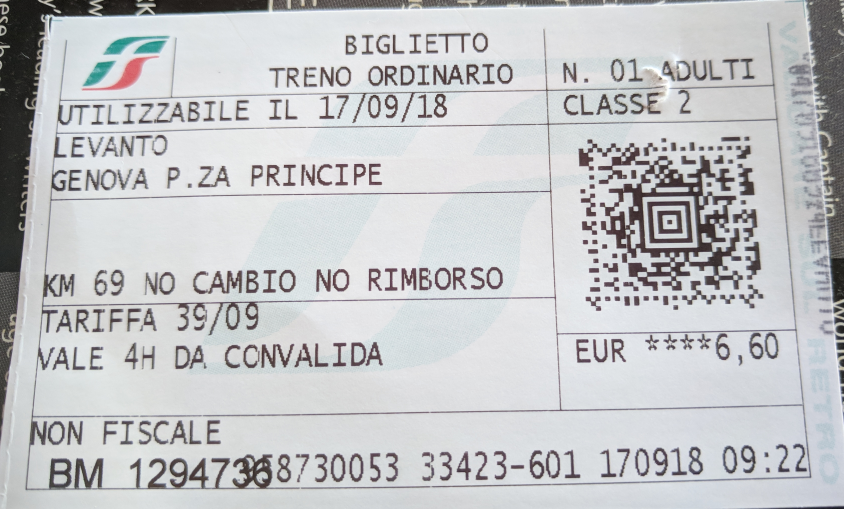
Notice that each ticket has something printed along an edge. It didn't come out of the ticket machine with that. Before you use any ticket that you don't buy in advance for a specific date and time of travel - train, bus, metro, etc, you have to validate it.
(You
similarly need to validate bus and metro tickets - bus tickets when you
board the bus, metro tickets on a machine in the station - if you've
bought a multi-use pass, you only need to validate it the first time
you use it).
If you've bought your ticket online, you'll get an attachment with an electronic version of a ticket attached - sent either to an email address or as a text message to a phone number. You can print this out or display it on your phone or tablet screen - here's what one looks like - notice that it's in English!
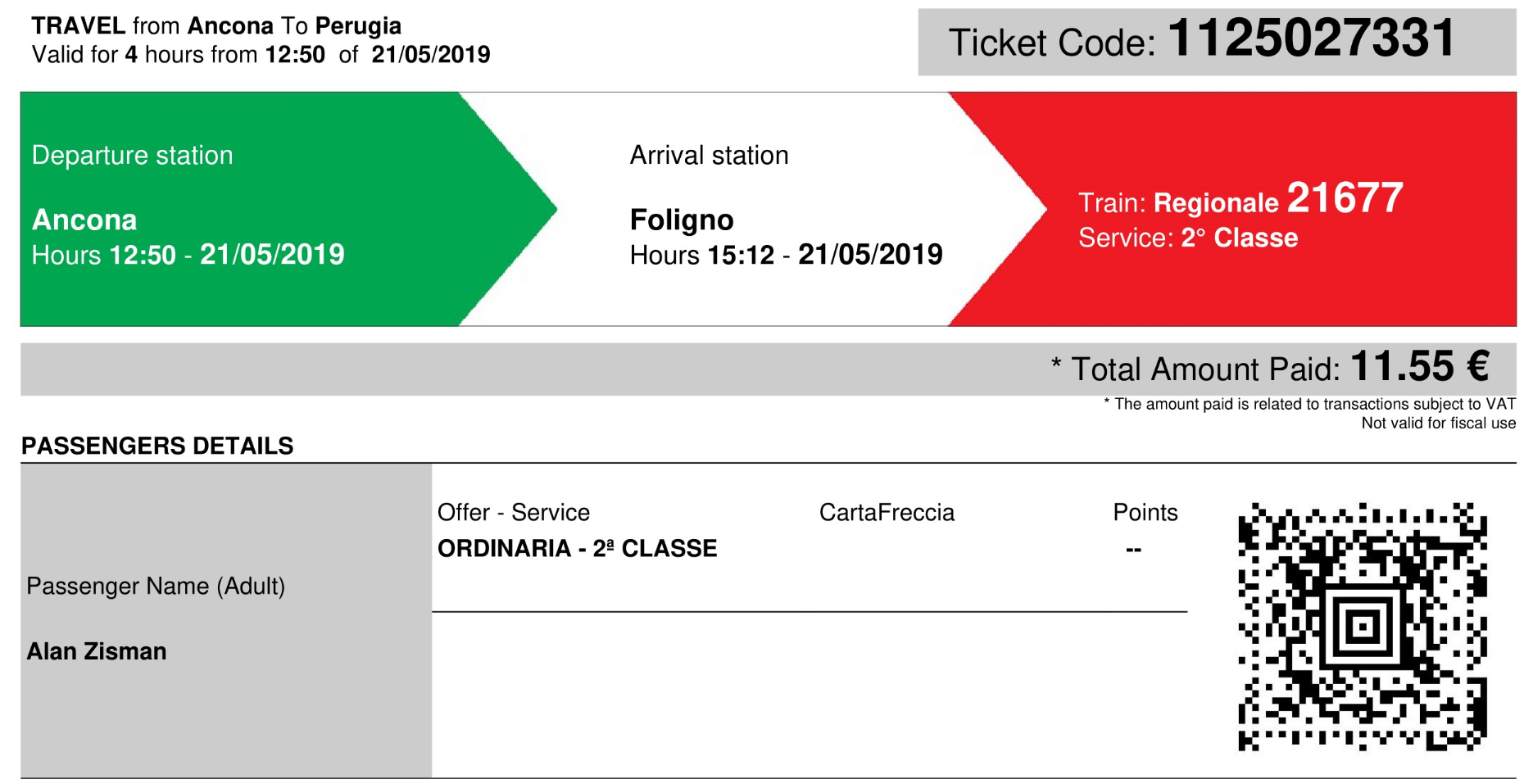
Note that if you buy multiple tickets you'll have to deal with multiple files on your device (which might be awkward) and if you're changing trains, each file will have multiple pages - one for each train you're travelling on, so you need to be sure you show the conductor the right page when you're asked to show your ticket. Obviously there's no way to validate these tickets - but since it has the date and the time on it, it's not necessary.
On nearly every train trip at some point while the train is in motion, a conductor will come around to see your ticket - and to check that it's been validated. He or she may scan your ticket with a tablet. If you haven't validated your ticket, you are subject to a fine - being a foreigner or a tourist or not speaking Italian is not an excuse.
If you use a lower-priced regionale ticket on a more expensive train - or a 2nd class ticket in a 1st class seat - you may be asked to pay the difference in fares plus a fine. You need to pay right then and there - the conductors accept cash, or can process credit cards even on a moving train.
If you have multiple tickets (as in the Varenna to Venice trip I mentioned above) you'll need to validate each ticket - validate the second ticket when you get to the station where you're changing trains.
You've been warned!
While the ticket has a lot of information (in Italian), there's one missing bit of information. Almost all train stations have multiple tracks. You need to know what track ('binario' in Italian) to go to in order to get on the right train. There are printed departure schedules (in yellow) posted around the station along with video screens for arriving and departing trains. Both of these list the binario where the train can be found. But in many cases, there's a catch.
We've bought a ticket - in this case - from Santa Margheritte to Genova Principe. But when I look at the departures board at the station, I don't see my destination listed.
It turns out that the train I'm going to be travelling is ending up in Milan ('Milano') - Genova Principe is just one of the stations it will be stopping at. It's listed on both the yellow printed sheet and on the video screen as a train for Milano. But my ticket doesn't say that anywhere! How can I find the information I need?
The larger ticket does give two pieces of useful information. One is the train number - on our ticket it's 'Treno 665'. The other is the departure time: 13.47. (The smaller ticket lacks that information - you might want to jot the departure time down on a scrap of paper when you're buying the ticket).
Take a look at the yellow printed departure schedule (not the white arrival schedule) - found in several places around the station (note that it doesn't look yellow in the photos below):
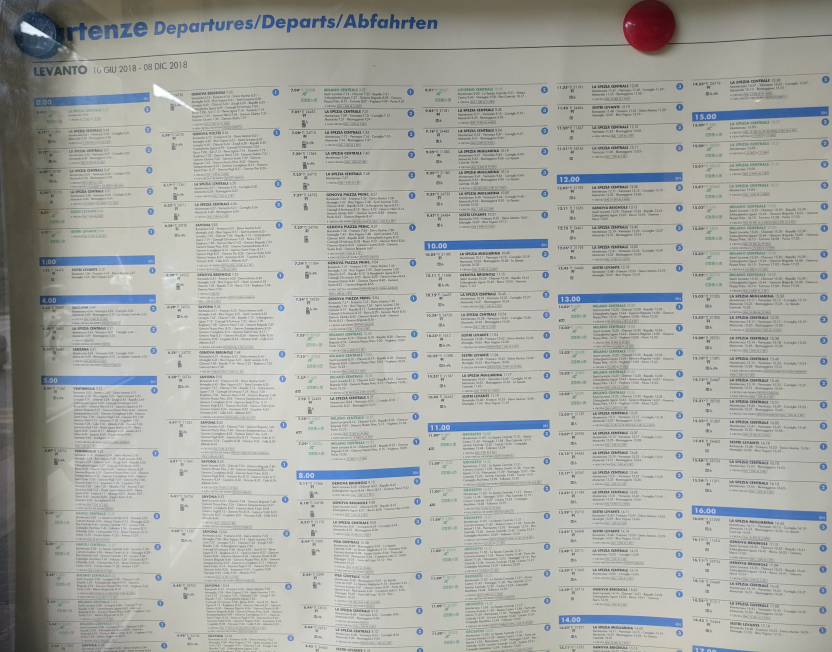
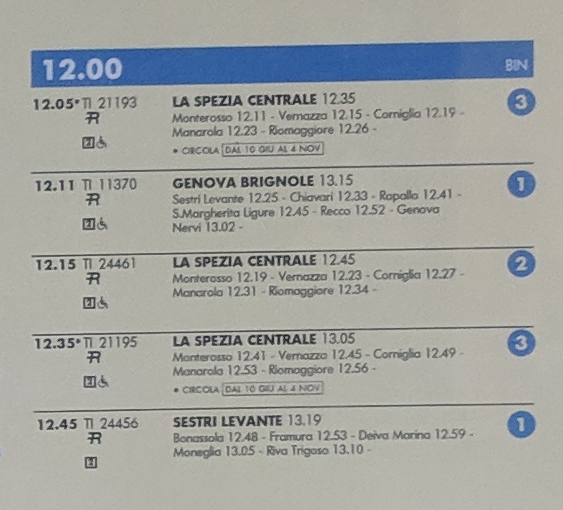 Here's
a blowup of a section of the departure schedule.... you'll see the
trains leaving this station startiong at 12.00 (noon) - check the
departure time; the final destination of each train is in big letters,
below that are the various stops, along with the scheduled arrival
times. Hopefully you can find which train you have a ticket for. Along
the right, the numbers on the blue circles indicate the track number
('Bin' for 'binario').
Here's
a blowup of a section of the departure schedule.... you'll see the
trains leaving this station startiong at 12.00 (noon) - check the
departure time; the final destination of each train is in big letters,
below that are the various stops, along with the scheduled arrival
times. Hopefully you can find which train you have a ticket for. Along
the right, the numbers on the blue circles indicate the track number
('Bin' for 'binario').
But there's another possible problem. Sometimes the binario has changed - after the poster has been printed.
So double-check by taking a look at the up to the minute video screen. There's typically a large screen in the lobby of the station, with smaller versions at various places around the station, including alongside the tracks.
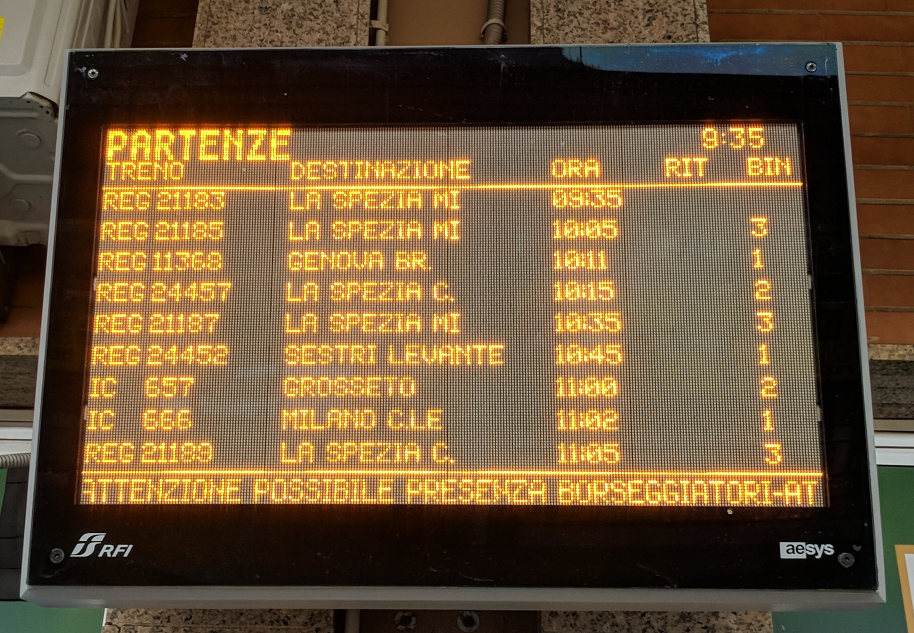 'Partenze'
= Departures. Again, this is showing the final destination of each
train - which may or may not be where you're going. Beside that 'Ora' (hour)
indicates the scheduled departure time. 'Rit' indicates whether the
train is late ('ritardo'). 'Bin' for 'binario' is the track where you
can get on the train.
'Partenze'
= Departures. Again, this is showing the final destination of each
train - which may or may not be where you're going. Beside that 'Ora' (hour)
indicates the scheduled departure time. 'Rit' indicates whether the
train is late ('ritardo'). 'Bin' for 'binario' is the track where you
can get on the train.
In many stations, in order to get to any binario other than track 1, you'll need to go down to an underground passage below the tracks, then back up to your desired track. There may be an elevator - but be prepared - you may need to drag your suitcase down and then up a flight of stairs and along a corridor. (And repeat the process when you arrive at your destination). This is one reason to try to get to the station with time to spare - and can be a problem if you're rushing to make a tight connection.
A few times, the binario has changed shortly before the train arrives - there should be a notification on the P.A. system about this - in Italian and then in English... so stay alert. we were in a suburban station outside Rome and suddenly, after an announcement that we hadn't understood everyone left the track except us. We finally looked at the screen and realized that the train we were waiting for was coming into a different track - we had to scurry with out baggage to get to the right place in time.
On the tracks there is usually another video screen showing the next train to arrive - and in small print scrolling through the various stations where that train will stop. You can check to make sure your destination is listed. There will be an announcement - in Italian and then in English - shortly before your train pulls up.
So you've validated your ticket (if you forgot, there's usually a validation machine somewhere on the track), found your binario, and dragged your baggage along. And finally your train has arrived!
Note that most train carriages have a big number 2 on the side - this isn't the number of the carriage - it indicates that it's a 2nd class carriage. A few carriages near the front have a number 1 on them - these are for first class passengers. Frankly there's not much difference - wider seats in first class. But no complimentary glasses of prosecco. (Still, when the difference between 1st and 2nd class is nominal, we've sometimes purchased 1st class tickets).
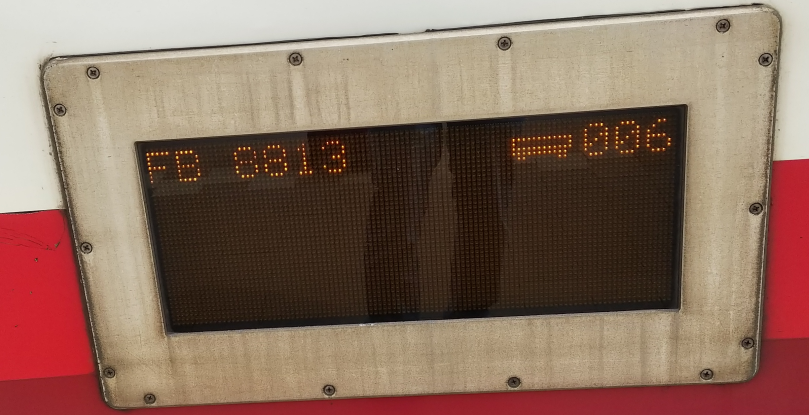 If
you have a reserved seat, find the right carriage - the number is
sometimes printed
on a piece of paper taped to the window on the door. On this Freccia
Bianca fast train, instead, there was a small electronic board beside
each entry door to the train giving the number of this train and the
carriage number - in this case, Carriage 6.
If
you have a reserved seat, find the right carriage - the number is
sometimes printed
on a piece of paper taped to the window on the door. On this Freccia
Bianca fast train, instead, there was a small electronic board beside
each entry door to the train giving the number of this train and the
carriage number - in this case, Carriage 6.
There's usually a conductor alongside the train who can help you if you have questions.
Get onboard and find your seat. If there's no reserved seating, sit anywhere you like. There is usually an open baggage area at the end of the carriage and often a baggage rack in the middle. There are overhead places for baggage - it can be a chore getting a big suitcase up, but fellow passengers will often offer to help. In some cases, you can squeeze a suitcase in the space between two seats.
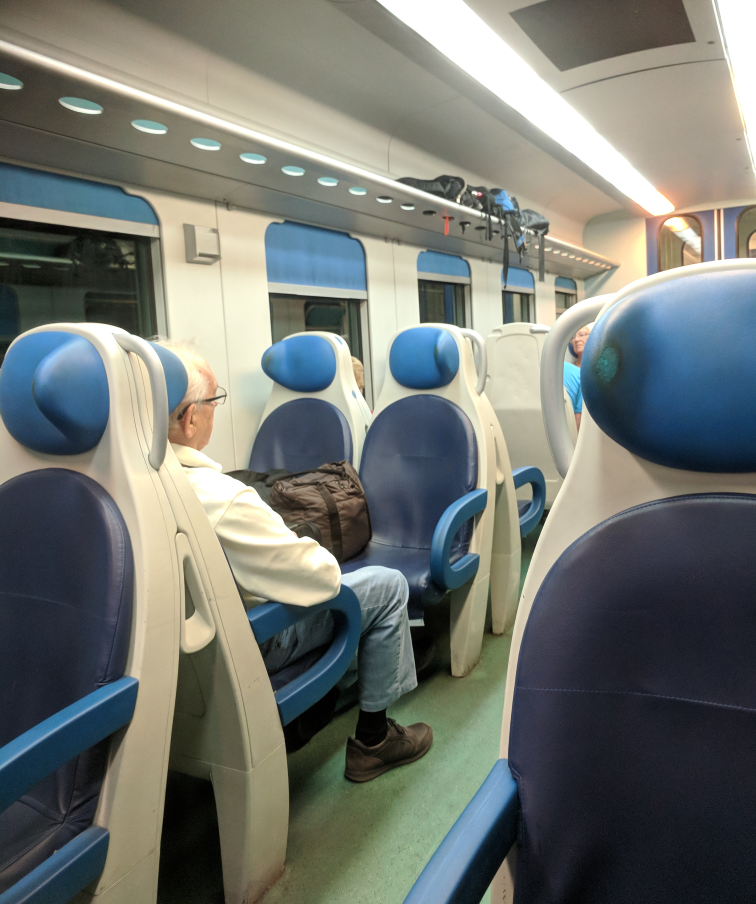 This photo was taken in a second
class carriage of a regionale train. It's reasonably comfortable -
certainly roomier than economy class on a plane! Clean, modern. Just
fine.
This photo was taken in a second
class carriage of a regionale train. It's reasonably comfortable -
certainly roomier than economy class on a plane! Clean, modern. Just
fine.
You may find older carriages on some of the secondary routes - don't blame me if your train doesn't look like this. On the other hand, Intercity trains will be a bit fancier, often with multiple levels. And the high speed Freccia train interiors are positively space age, with video screens reporting the train's current speed, which can be reach up to 400 km/hour or so as the train speeds through the countryside.
Note however that the train cars - especially on the local regionalle trains - get older the further south you go in the country. While local train cars in Lombardy (in the north) look pretty space age, those in Puglia look like they were new in the 1950s.
An aside:
Several cities have suburban train lines that integrate with those cities' local bus or metro systems. For instance, in Rome, there's a train line that starts in a station right beside the Piramide metro station and runs down to the Ostia beach resort town. Your Rome metro ticket can be used for these trains (and vice versa) - no additional ticket needed. In Genoa, a train line runs through western and eastern suburbs - tickets to these stations currently costs a modest €1.60 - and can be used for additional travel on the city's bus/metro/funicular/elevator network, replacing a €1.50 bus ticket. The trick - the standard Trenitalia ticket machines in these suburban stations (which also service the national trains) look like they'll sell you the needed ticket - but then don't show any available trains - instead, buy your ticket from a ticket agent (if the station has one) or from a 'tabachi' - the vendor of cigarettes, who also sell bus tickets in most Italian towns. The Genoa Nervi station has a tabachi stand right inside the station, for instance - in Roma-Piramide, there's a tabachi inside the metro station, right beside the south-side exit.
A story - May 2019 we were staying in Lecce in Puglia - we wanted to take a day trip to the beachfront town of Otranto - about an hour and a half away by train, costing about 3.50 Euro each way. The catch was that the journey - according to the Trenitalia web page - required two chages, each with a tight 2 minute connection time. Was that going to be possible? We got on the first train in Lecce, an older somewhat run-down looking train - and it sat in the station for 10 minutes or so. We thought there was no way we going to be able to make that first connection and were about to get off and try to get refunds on our tickets, but the conductor assured us that everything would be just fine.
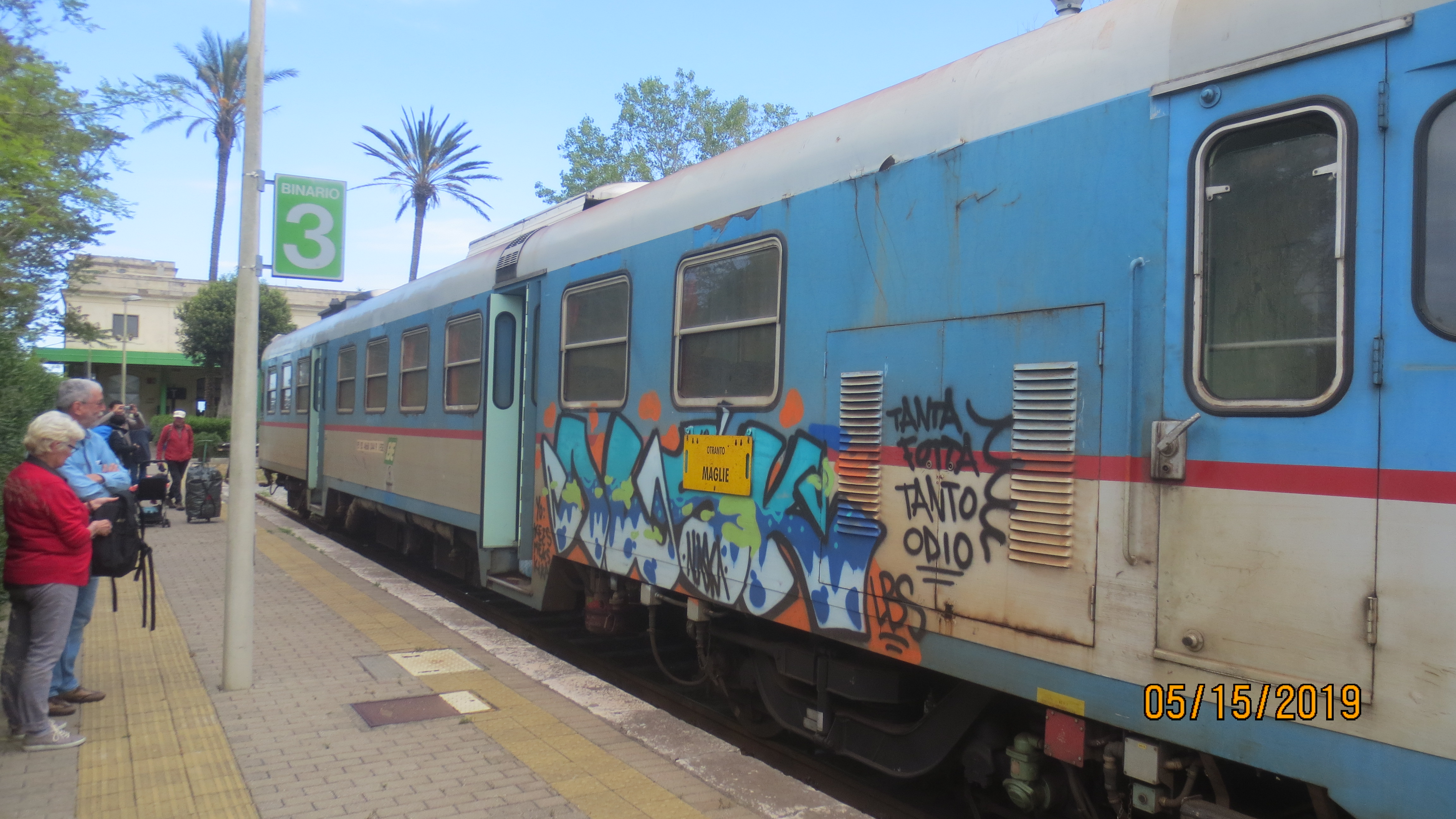 In the town where we were supposed to
switch trains, there was nothing waiting. Instead, the first
train was split into two - one half went to the town of Gallipoli, on
Puglia's west coast, the other, which was the one we wanted, went on
south - so there was no way we couldn't make that connection - as long as we were in the correct car.
In the town where we were supposed to
switch trains, there was nothing waiting. Instead, the first
train was split into two - one half went to the town of Gallipoli, on
Puglia's west coast, the other, which was the one we wanted, went on
south - so there was no way we couldn't make that connection - as long as we were in the correct car.
In the next place we were supposed to switch trains, there was a train already at the station, awaiting our arrival - so even though we had started late, there was - as the conductor had assured us - no problem. We arrived in Otranto a few minutes later than the scheduled time, but with no complications.
The moral: The Italian train system works surprisingly well, even when you think it won't.
One more thing: You probably want to bring something to eat and drink on board - especially for a longer trip. The high-speed Frecciarossa (etc) trains have a snack bar on board, and though you can get beer, prosecco, etc, I haven't been impressed with the food. On the other hand, many mid-sized train stations have bar/caffes inside (or right outside) with pretty good take out sandwiches, drinks, pastries, etc. The large city train stations (Rome, Florence, etc), on the other hand, tend to have MacDonalds or other chain fast food outlets, though they may also have a more Italian-style bar/caffe. You probably don't want to eat the food sold in vending machines at the binnarios (tracks). Stick to the bar inside the station.
I hope you've found this helpful - and that you have a great trip. Email me if you have questions or comments.
More information:
Everything You Need to Know About Traveling Italy by Train — From the Best Routes to Local Tips
Train Travel in Italy - Top Tips to Travel by Train
19 Dos and Don’ts of Italian Train Travel - Italy Segreta - Travel
Seat 61: A beginner's guide to Train Travel in Italy
July 2022 news: New High-Speed Rail Service Connecting Rome’s Airport with Florence and Naples
Feb 2024: Italy's high-speed Frecce trains bring in new luggage rules
You may also want to take a look at:
For a more general article on train travel in Europe, see: Getting Around Europe by Train
A nice piece about Italy's high-speed trains: Frecce + Italo: How Italy's high-speed trains helped kill Alitalia
Comparing Italy's high-speed trains and the slower local trains most Italians rely on: Two-Track Nation: What Italy's Trains Say About The Limits Of Progress
And to practice your Italian: Italian Conversations: Buying a Ticket At the Train Station
Older blog postings....
By Alan Zisman © 2018-09-20; updated 2024-09-06
We love Italy and go there whenever we can - though it's more of a ordeal getting there from the West Coast of Canada than, say, the UK. We just got back from our 10th trip this week (as of September 2018 - as of 2023 we're up to 13 trips). Much to the surprise of some folks we know, though, we've never rented a car - when we're there, we get around on foot much of the time, and when that won't work, we go by train.
The Italian train system goes to all the big and medium-sized cities and lots of the small towns. (Not all of them - once in a while we have to take a bus. But not usually). And train service is reasonably comfortable, reasonably quick, and reasonably inexpensive - about half the cost of comparable British service, for instance.
There are some quirks - magnified by language, though the Italian train system tries to offer its services in English alongside Italian.
A few things to know to get started - most of the trains are part of a nationalized country-wide network run by Gruppo Ferrovie dello Stato Italiane under the name Trenitalia. There is some competition from Italo - but they only operate between major cities. There are some local, independent rail lines, like the Circumversuviana line that goes between Naples and Sorrento, with stops including Pompei. But most of the time, you'll be dealing with Trenitalia - and that's what I'm going to focus on.
New 2023-10-12: Trenitalia offers foreigners a Trenitalia Pass - allowing for multiple train tips within a period of time. 4 options range from 3-4 journeys within 7 days, 7 journeys within 15 days, 10 journeys within 30 days and prices starting at €129. This may be a good deal for you - personally, it seems like a lot of train travel - more or less a long train ride every second day. If you are planning to stay in a home base (or several home bases) with perhaps shorter day-trips, it would probably be less expensive to book the long train rides ahead of time and then be spontaneous about your shorter, regional day-trips.
Trenitalia offers three levels of trains: Regionale trains are the local trains - they run, mostly within a single region, as the name suggests - stopping at many small stations along the way. Slowest, due to the frequent stops, but also the least expensive option. No reserved seats. You can sometimes buy first class or second class tickets - first class has 3 seats in a row, second class has 4 seats in a row, but otherwise there's not much difference. (Not all trains have first class seating available). Sometimes we've found first-class tickets going for not much more than 2nd class - but usually we travel 2nd class.
Intercity trains make fewer stops at small stations - making for a faster run at a higher price. Often, tickets include assigned seating on these trains - so make sure you sit in the assigned seats.
 'Freccia'
trains (Italian for 'arrow') offer the fastest service - only available
between major cities. You pay extra for the extra speed (up to 400 km/hr!). For instance,
you can travel from downtown Rome to Venice in 3 hours and 45 minutes
on a Frecciargento ('Silver Arrow') or Frecciarossa ('Red Arrow') for
€50-75. Or spend 6 hours on an Intercity train for €57. Or you could take 11 hours (including 2 changes) on a series of
Regionale trains for €42. I know which I would choose!
'Freccia'
trains (Italian for 'arrow') offer the fastest service - only available
between major cities. You pay extra for the extra speed (up to 400 km/hr!). For instance,
you can travel from downtown Rome to Venice in 3 hours and 45 minutes
on a Frecciargento ('Silver Arrow') or Frecciarossa ('Red Arrow') for
€50-75. Or spend 6 hours on an Intercity train for €57. Or you could take 11 hours (including 2 changes) on a series of
Regionale trains for €42. I know which I would choose!I find Trenitalia's online scheduling information very useful and refer to it often - both before travelling and while I'm in Italy. It lets me know if there is train service where I'd like to go - and if so, how often it runs. If there are a couple of trains each hour, then I can be pretty flexible in my planning. If there's just one train in the afternoon and one in the evening, though, I want to make sure I get to the station on time!
Note- prices on Intercity and Frecce trains will be more expansive getting tickets for that day compared to booking well in advance. For instance, I had looked at train options from Tivoli to Salerno several months prior to our trip - the train we thought we might take was listed as costing 26 Euro. We didn't get tickets - our plans were not yet finalized. Arriving in the station the day we wanted to travel, the same trip cost is double - 52 Euro... Similarly, a train from Lecce to Ancona jumped from 35 Euro well in advance to 70 Euro a few days prior to departure. Ancona to Perugia price jumped from 11.55 Euro to 34.65 Euro (tripling!) two days prior to departure. More on when to book for the best price below.
Short (regional) tickets, however, are the same price in advance or on the day - so no need to book ahead of time.
| Update 2019-07-04: I experimented on the Trenitalia website
to see the cost of tickets to go from Milan to Turin (Milano to
Torino), starting with the next day, and then checking a day at a time, a week
at a time, then a month at a time. Travelling the next day on the high speed Freciarosa (a 1 hour trip) cost €36; the 2 hour trip on a regionale veloce train cost €12.45. (Note - these were the 2019 prices; they may have changed by now). Looking ahead a day, the price for the Freciarosa dropped to €25.90 - about a 28% savings. The regionale veloce ticket stayed the same. The following day, the Freciarosa ticket dropped to €23.90, and fell to €21.90 the day after that. For the rest of that week, it dropped to €19.90. For the next week (7-13 days in advance), it fell further to €17.90,16.90 if you bought it 2 weeks in advance and to €14.90 if you bought it 3 weeks in advance - though it went back up to €17.90 if you wanted to travel on Mondays or Tuesdays. From 4 weeks in advance, though, it went back up to €17.90 - and stayed there for the next couple of months. More - I'm making a few train trips in October (2019) - one from Milan to Turin, and one from Alba (in Piedmont) back to Milan. I checked prices in early September, 5-6 weeks before my train trips. I compared buying tickets now (for the October trips) to buying the same tickets to travel tomorrow and 3-4 weeks in the future. Travelling from Milano Centrale to Torino Porto Nuova tomorrow on the one hour Frecciarossa would cost €36. Booking 3 1/2 weeks in advance, the price drops to €16.90, while booking for the October date I actually need is down to €14.90. (The slower - 2 hour - Regionale Veloce was the same €12.45 no matter what date I looked at). Note that there's an additional €2 charge to reserve seats on the Frecciarossa - an option that's not available on the slower trains. |
My advice - buy your long haul fast train tickets at least 3 weeks in advance online for the best prices, but let yourself be spontaneous with local day trips - no need to overplan these. If that's not practical, booking those trips in advance - even a day in advance - will still bring significant savings in price.
But - when I was online looking at the recently tripled Ancona-Perugia tix two days prior to departure, and clicked on a departure time, I noticed a 'View other offers' button. Clicking that offered me the same tickets for the old price! (This was available using my laptop and on my phone, where the equivalent button said 'More offers'). Needless to say, I bought those tickets! This won't always work (it didn't on my fantasy Milan-Turin experiment) but be sure to check if you're buying a ticket on a fast train leaving in the next couple of days.
More: When To Buy Train Tickets In Italy To Get The Best Deal: https://www.explore.com/1559781/when-buy-train-tickets-italy-get-best-deal/
Trenitalia's website is available in English: https://ca.trenitalia.it-inter.com/ - you can customize it for your country, prefered currency, and language. New feature (Sept 2018) - you can now enter Italian city names with your choice of the English language name or the Italian name: Rome vs Roma, Florence vs Firenze, Venice vs Venezia, etc. Previously, even if you were using the English language version of the website, you needed to know and use the Italian version of city names.
(The older English language page: https://www.trenitalia.com/en.html is still online and may work more efficiently - but requires you to use Italian-language city names - Roma, Genova, Milano, etc). The illustrations below were captured on the new page.
Both Trenitalia and ItaliaRail have smartphone apps that can used to purchase tickets - delivered digitally right to your phones. However, I was unable to install the Trenitalia Android app from outside Italy - I'll try to get it when I'm back in Italy!
| Here, on the Trenitalia English language home page, I've started to search for options travelling from the city of Genoa (Italian: Genova). As I started to type, in the From field, a list of possible stations appeared - I could scroll down it to pick a specific station from the list (Genoa lists 25 stations!) or just pick the city name to get all possible options. (You may want to do a bit of online research to see what's the main or most centrally located station). | 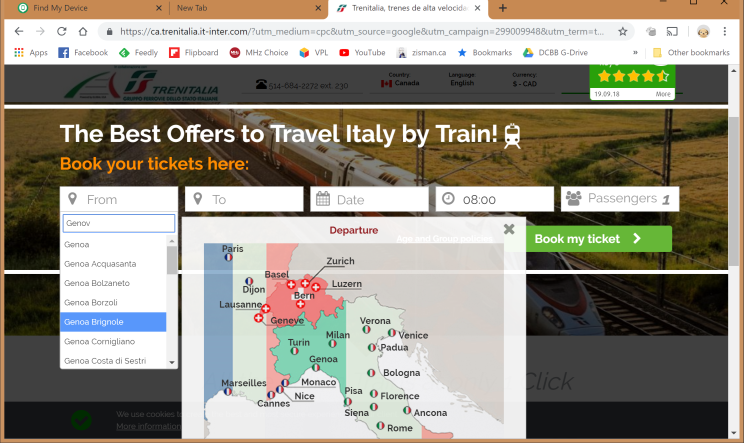 |
| Repeat to choose a destination station (I want to go to the Riviera town of Levanto), date, and approximate time. | |
| Clicking 'Book my ticket' (even though I'm just looking) gets a list of trains going from Genoa Brignole station to Levanto. I see a variety of options, slower Regionale options (with a change), an Intercity option for over double the cost. More if I scrolled down, including several direct trains. | 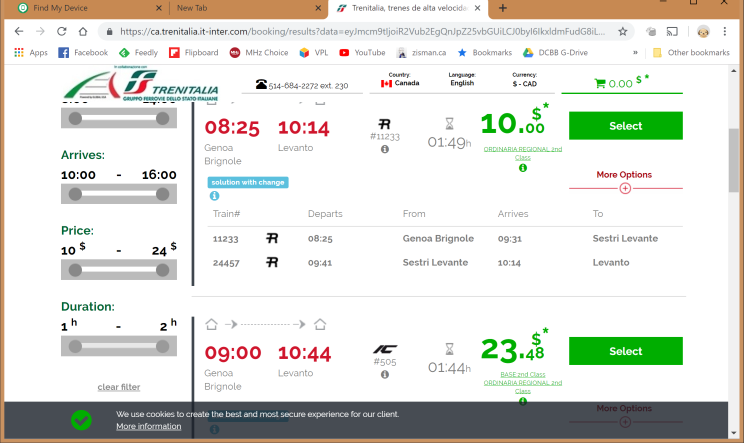 |
| If I select one of the options, I'm offered more details and asked for my name in order to 'Add to Cart'. If I actually wanted to purchase tickets this way, I would need to provide more information including a credit card to buy the tickets. | 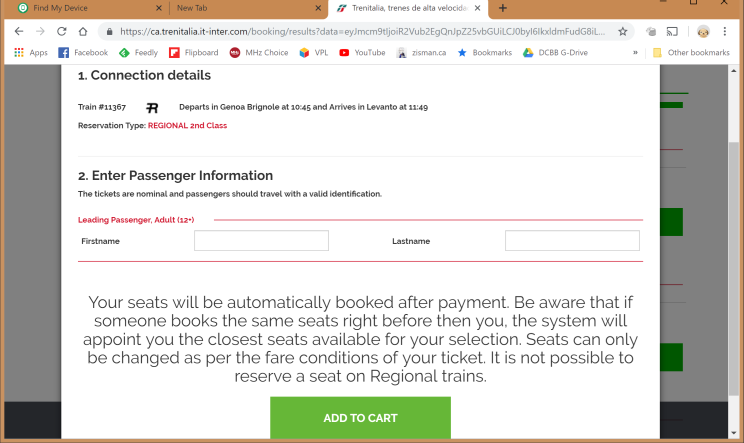 |
Some things can be misleading, however. I checked whether there were train connections from Salerno to Matera and saw:

Looks like there are two options, right? But a couple of things that may not be immediately obvious - the 'Trains' are listed as 'Freccialink' which refers to buses going to or from places lacking train service. And there's no price listed - in fact, despite showing these options on their website (and on ticket machines at a station), this service seems to be imaginery - which would be unfortunate if you planned a trip assuming the service existed, as I did! (Luckily, the German bus company Flixbus, provided connections, though it dropped us off in Matera at an out-of-the way location - affordable tickets to and from many European locations).
So when I get to Genova Brignole, I'm going to wander over to one of the Trenitalia ticket machines scattered around the lobby of the station. Note that you may see a mix of Trenitalia ticket machines and machines from the alternative ItaliaRail company ('Italo'). Pick the one you want - though remember that Italo only services major cities, so it won't get me from Genoa to Levanto.
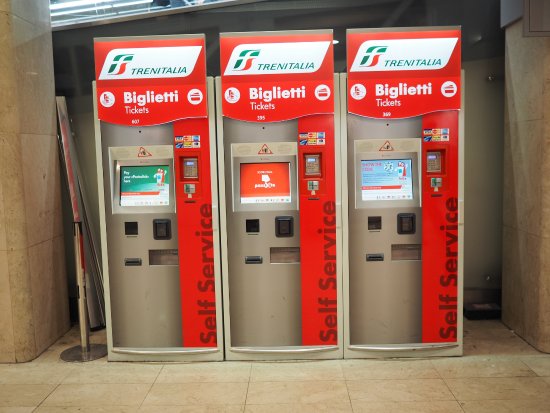 Trenitalia ticket machines | 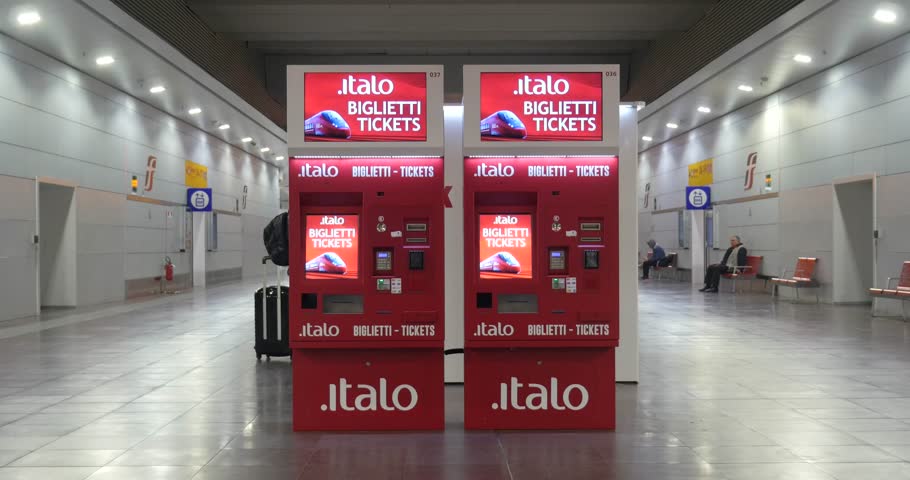 Italo ticket machines |
They feature touch screens - and the first screen includes a set of small flag icons along the bottom of the screen to change the language from Italian. Tap a finger on the UK flag icon to change the language to English. When you do that, you'll get a new screen - with a voice in delightfully Italian-accented English warning you to 'Beware of Pickpockets' - thus letting everyone in the station know that an English-speaking tourist is in their midst.
(Do take pickpockets seriously! Crowded, busy train stations can be places frequented by pickpockets. See, for instance: Train Scams and Pickpockets – What to watch out for)
The ticket machines work similarly to the website, but with an older version of the software that doesn't let you use the English versions of Italian city names. You have to use Genova, Roma, Firenze, Venezia, Milano, etc.
In larger stations, if you prefer, you can get your tickets the old fashioned way - from a ticket agent at a counter. But you'll probably have to wait in line and deal with someone who's English is only a bit better than your Italian. And many smaller stations have no ticket office - you'll just have to deal with a ticket machine.
| I took these photos at the station in Levanto, wanting tickets to return to Genoa (a.k.a. Genova). You can use the ticket machines to pick a station other than where you are now (in this case, Levanto) and for a different day than today - but I skipped those options - so I just need to choose an arrival station. As I started to type Genova, a list of possible stations shows up. | 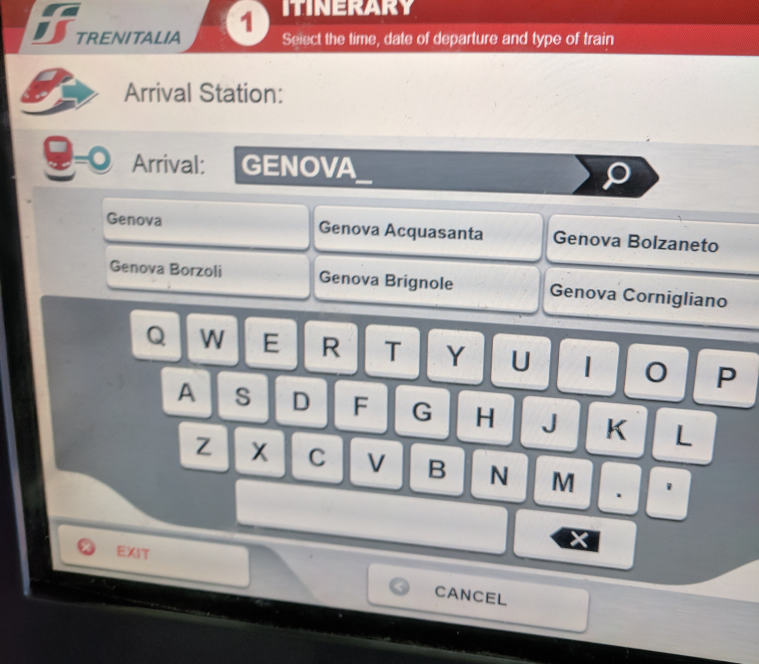 |
| Note that on the touch screen, I've found that touching the bottom of the buttons gives the best results. When you see where you want to go, touch the button - I want to go to Genova Brignole. | |
| After a screen where I confirm the date I want to travel and the approximate time, I get a list of possible trains - as on the website, a mix of regionale and intercity choices, direct trains or routes where I have to change trains. Various prices and various durations. The non-stop regionale trains take the same 1.04 hours as the more expensive intercity option. | 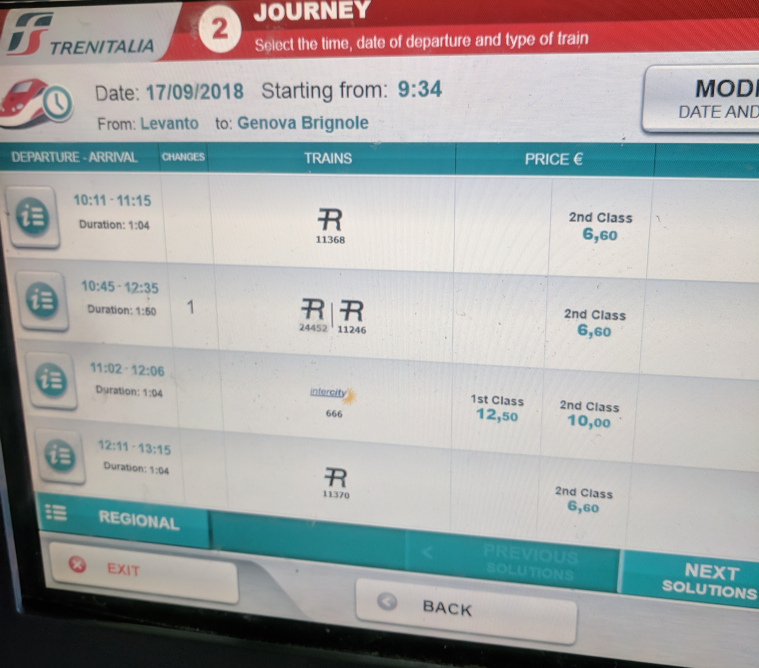 |
| Since I picked a regionale train, I only have the option of a 2nd Class ticket - with no assigned seating. I can change the number of tickets I need - adults, children, and animals. (Dogs are allowed - muzzled and on leash). | 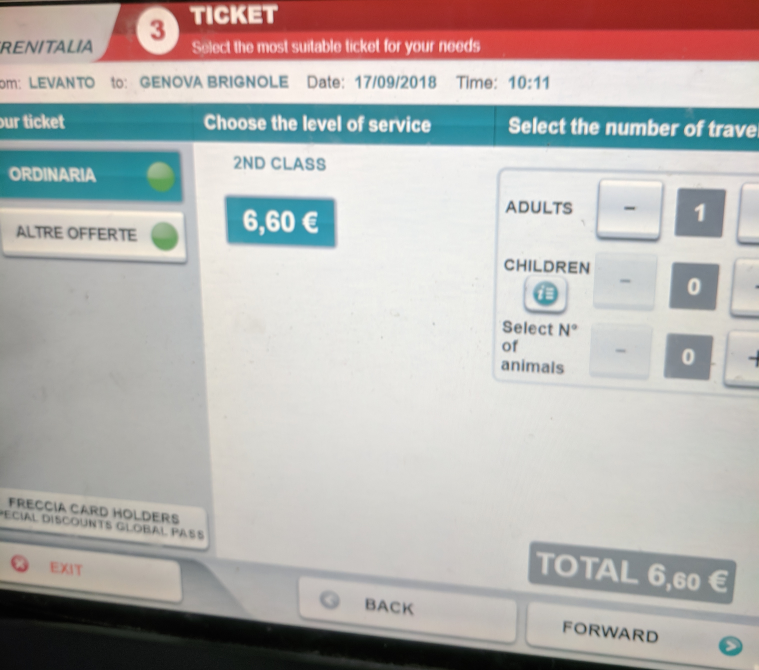 |
| After
a few confirmation screens, you're given a payment screen. You can
choose cash, debit, or credit - inserting cash or your credit card in a
section to the right of the screen. If you're paying by cash, change is
given. If you're using a card, there's a separate number pad letting
you enter your PIN. (You may need a card with an embedded chip). Finally, your tickets will be printed out. | 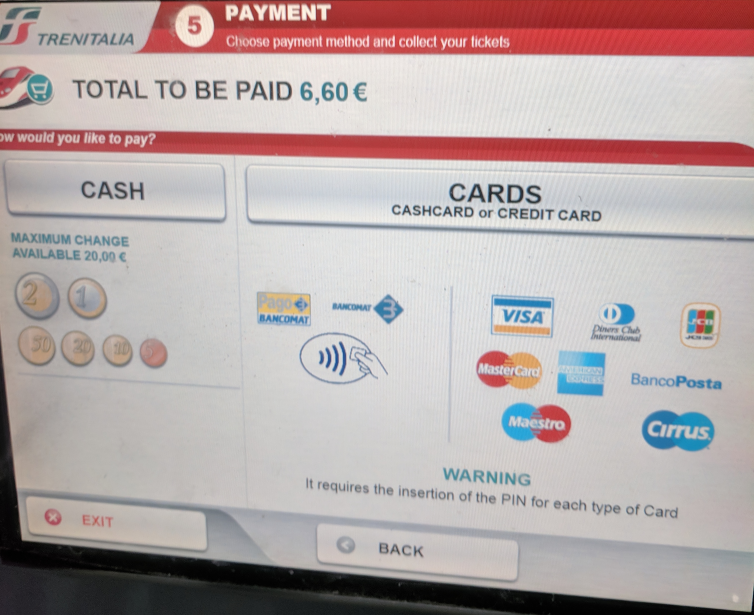 |
| There are several style of tickets - here's an example of the larger style, for a trip from Genova Piazza Principe ('Partenza') to Santa Margheritta ('Arrivo'). It gives the date ('Data') and time ('Ora') for both departure and arrival and that it's 2nd class. (Click to see a larger version). | 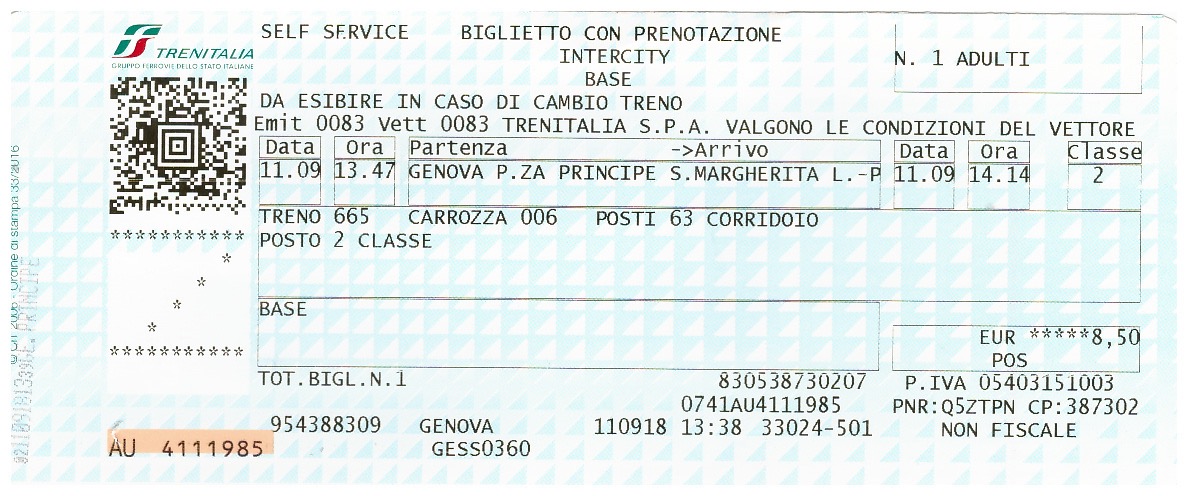 |
If your proposed trip requires that you change trains, you will get separate tickets for each leg of the trip. For instance, in 2017, we went from Varenna (on Lake Como) to Venice - we had to change trains in Milan. So the machine at the small station in Varenna printed out two tickets - one for the Varenna-Milan train, the second for Milan-Venice. The second ticket included reserved seats. Note that you'll have to exit the first train, figure out the binario (track #) for the second train, and haul your luggage there, in some cases pretty quickly!
Here's a smaller ticket for a different trip:

Notice that each ticket has something printed along an edge. It didn't come out of the ticket machine with that. Before you use any ticket that you don't buy in advance for a specific date and time of travel - train, bus, metro, etc, you have to validate it.
| Throughout
the station, you'll see machines like these - note the two different
styles: Each has a slot - insert your ticket (printed side up
- it doesn't matter which end) and push it in as far as you can. Slide
it to the left edge of the slot and you'll hear a bit of whirring. The date and time will be printed onto that edge of your ticket - validating it. Validating your ticket is a way to ensure that you only use your ticket once. | 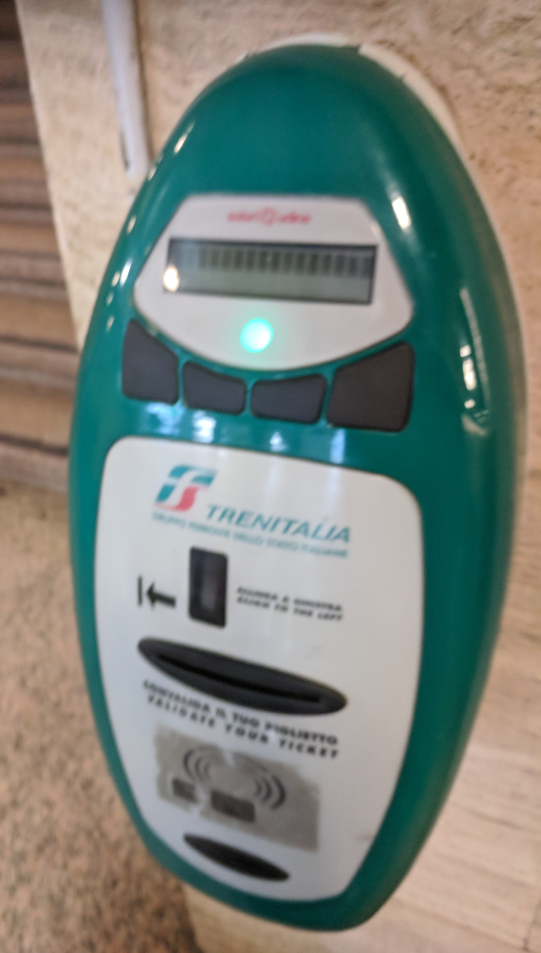 | 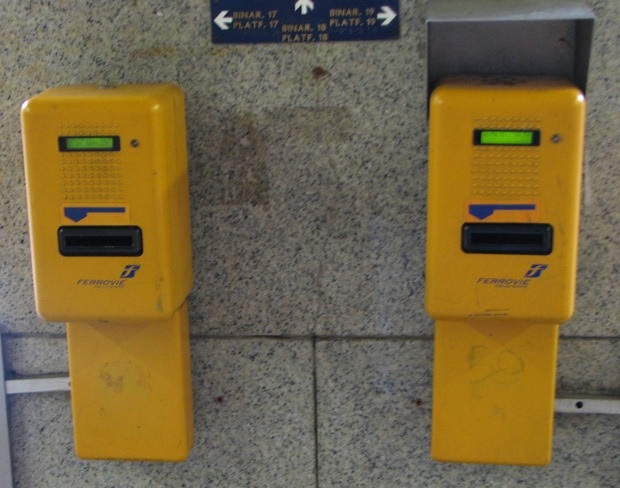 |
If you've bought your ticket online, you'll get an attachment with an electronic version of a ticket attached - sent either to an email address or as a text message to a phone number. You can print this out or display it on your phone or tablet screen - here's what one looks like - notice that it's in English!

Note that if you buy multiple tickets you'll have to deal with multiple files on your device (which might be awkward) and if you're changing trains, each file will have multiple pages - one for each train you're travelling on, so you need to be sure you show the conductor the right page when you're asked to show your ticket. Obviously there's no way to validate these tickets - but since it has the date and the time on it, it's not necessary.
On nearly every train trip at some point while the train is in motion, a conductor will come around to see your ticket - and to check that it's been validated. He or she may scan your ticket with a tablet. If you haven't validated your ticket, you are subject to a fine - being a foreigner or a tourist or not speaking Italian is not an excuse.
If you use a lower-priced regionale ticket on a more expensive train - or a 2nd class ticket in a 1st class seat - you may be asked to pay the difference in fares plus a fine. You need to pay right then and there - the conductors accept cash, or can process credit cards even on a moving train.
If you have multiple tickets (as in the Varenna to Venice trip I mentioned above) you'll need to validate each ticket - validate the second ticket when you get to the station where you're changing trains.
You've been warned!
While the ticket has a lot of information (in Italian), there's one missing bit of information. Almost all train stations have multiple tracks. You need to know what track ('binario' in Italian) to go to in order to get on the right train. There are printed departure schedules (in yellow) posted around the station along with video screens for arriving and departing trains. Both of these list the binario where the train can be found. But in many cases, there's a catch.
We've bought a ticket - in this case - from Santa Margheritte to Genova Principe. But when I look at the departures board at the station, I don't see my destination listed.
It turns out that the train I'm going to be travelling is ending up in Milan ('Milano') - Genova Principe is just one of the stations it will be stopping at. It's listed on both the yellow printed sheet and on the video screen as a train for Milano. But my ticket doesn't say that anywhere! How can I find the information I need?
The larger ticket does give two pieces of useful information. One is the train number - on our ticket it's 'Treno 665'. The other is the departure time: 13.47. (The smaller ticket lacks that information - you might want to jot the departure time down on a scrap of paper when you're buying the ticket).
Take a look at the yellow printed departure schedule (not the white arrival schedule) - found in several places around the station (note that it doesn't look yellow in the photos below):

 Here's
a blowup of a section of the departure schedule.... you'll see the
trains leaving this station startiong at 12.00 (noon) - check the
departure time; the final destination of each train is in big letters,
below that are the various stops, along with the scheduled arrival
times. Hopefully you can find which train you have a ticket for. Along
the right, the numbers on the blue circles indicate the track number
('Bin' for 'binario').
Here's
a blowup of a section of the departure schedule.... you'll see the
trains leaving this station startiong at 12.00 (noon) - check the
departure time; the final destination of each train is in big letters,
below that are the various stops, along with the scheduled arrival
times. Hopefully you can find which train you have a ticket for. Along
the right, the numbers on the blue circles indicate the track number
('Bin' for 'binario').But there's another possible problem. Sometimes the binario has changed - after the poster has been printed.
So double-check by taking a look at the up to the minute video screen. There's typically a large screen in the lobby of the station, with smaller versions at various places around the station, including alongside the tracks.
 'Partenze'
= Departures. Again, this is showing the final destination of each
train - which may or may not be where you're going. Beside that 'Ora' (hour)
indicates the scheduled departure time. 'Rit' indicates whether the
train is late ('ritardo'). 'Bin' for 'binario' is the track where you
can get on the train.
'Partenze'
= Departures. Again, this is showing the final destination of each
train - which may or may not be where you're going. Beside that 'Ora' (hour)
indicates the scheduled departure time. 'Rit' indicates whether the
train is late ('ritardo'). 'Bin' for 'binario' is the track where you
can get on the train.In many stations, in order to get to any binario other than track 1, you'll need to go down to an underground passage below the tracks, then back up to your desired track. There may be an elevator - but be prepared - you may need to drag your suitcase down and then up a flight of stairs and along a corridor. (And repeat the process when you arrive at your destination). This is one reason to try to get to the station with time to spare - and can be a problem if you're rushing to make a tight connection.
A few times, the binario has changed shortly before the train arrives - there should be a notification on the P.A. system about this - in Italian and then in English... so stay alert. we were in a suburban station outside Rome and suddenly, after an announcement that we hadn't understood everyone left the track except us. We finally looked at the screen and realized that the train we were waiting for was coming into a different track - we had to scurry with out baggage to get to the right place in time.
On the tracks there is usually another video screen showing the next train to arrive - and in small print scrolling through the various stations where that train will stop. You can check to make sure your destination is listed. There will be an announcement - in Italian and then in English - shortly before your train pulls up.
So you've validated your ticket (if you forgot, there's usually a validation machine somewhere on the track), found your binario, and dragged your baggage along. And finally your train has arrived!
Note that most train carriages have a big number 2 on the side - this isn't the number of the carriage - it indicates that it's a 2nd class carriage. A few carriages near the front have a number 1 on them - these are for first class passengers. Frankly there's not much difference - wider seats in first class. But no complimentary glasses of prosecco. (Still, when the difference between 1st and 2nd class is nominal, we've sometimes purchased 1st class tickets).
 If
you have a reserved seat, find the right carriage - the number is
sometimes printed
on a piece of paper taped to the window on the door. On this Freccia
Bianca fast train, instead, there was a small electronic board beside
each entry door to the train giving the number of this train and the
carriage number - in this case, Carriage 6.
If
you have a reserved seat, find the right carriage - the number is
sometimes printed
on a piece of paper taped to the window on the door. On this Freccia
Bianca fast train, instead, there was a small electronic board beside
each entry door to the train giving the number of this train and the
carriage number - in this case, Carriage 6. There's usually a conductor alongside the train who can help you if you have questions.
Get onboard and find your seat. If there's no reserved seating, sit anywhere you like. There is usually an open baggage area at the end of the carriage and often a baggage rack in the middle. There are overhead places for baggage - it can be a chore getting a big suitcase up, but fellow passengers will often offer to help. In some cases, you can squeeze a suitcase in the space between two seats.
 This photo was taken in a second
class carriage of a regionale train. It's reasonably comfortable -
certainly roomier than economy class on a plane! Clean, modern. Just
fine.
This photo was taken in a second
class carriage of a regionale train. It's reasonably comfortable -
certainly roomier than economy class on a plane! Clean, modern. Just
fine.You may find older carriages on some of the secondary routes - don't blame me if your train doesn't look like this. On the other hand, Intercity trains will be a bit fancier, often with multiple levels. And the high speed Freccia train interiors are positively space age, with video screens reporting the train's current speed, which can be reach up to 400 km/hour or so as the train speeds through the countryside.
Note however that the train cars - especially on the local regionalle trains - get older the further south you go in the country. While local train cars in Lombardy (in the north) look pretty space age, those in Puglia look like they were new in the 1950s.
An aside:
Several cities have suburban train lines that integrate with those cities' local bus or metro systems. For instance, in Rome, there's a train line that starts in a station right beside the Piramide metro station and runs down to the Ostia beach resort town. Your Rome metro ticket can be used for these trains (and vice versa) - no additional ticket needed. In Genoa, a train line runs through western and eastern suburbs - tickets to these stations currently costs a modest €1.60 - and can be used for additional travel on the city's bus/metro/funicular/elevator network, replacing a €1.50 bus ticket. The trick - the standard Trenitalia ticket machines in these suburban stations (which also service the national trains) look like they'll sell you the needed ticket - but then don't show any available trains - instead, buy your ticket from a ticket agent (if the station has one) or from a 'tabachi' - the vendor of cigarettes, who also sell bus tickets in most Italian towns. The Genoa Nervi station has a tabachi stand right inside the station, for instance - in Roma-Piramide, there's a tabachi inside the metro station, right beside the south-side exit.
A story - May 2019 we were staying in Lecce in Puglia - we wanted to take a day trip to the beachfront town of Otranto - about an hour and a half away by train, costing about 3.50 Euro each way. The catch was that the journey - according to the Trenitalia web page - required two chages, each with a tight 2 minute connection time. Was that going to be possible? We got on the first train in Lecce, an older somewhat run-down looking train - and it sat in the station for 10 minutes or so. We thought there was no way we going to be able to make that first connection and were about to get off and try to get refunds on our tickets, but the conductor assured us that everything would be just fine.
In the next place we were supposed to switch trains, there was a train already at the station, awaiting our arrival - so even though we had started late, there was - as the conductor had assured us - no problem. We arrived in Otranto a few minutes later than the scheduled time, but with no complications.
The moral: The Italian train system works surprisingly well, even when you think it won't.
One more thing: You probably want to bring something to eat and drink on board - especially for a longer trip. The high-speed Frecciarossa (etc) trains have a snack bar on board, and though you can get beer, prosecco, etc, I haven't been impressed with the food. On the other hand, many mid-sized train stations have bar/caffes inside (or right outside) with pretty good take out sandwiches, drinks, pastries, etc. The large city train stations (Rome, Florence, etc), on the other hand, tend to have MacDonalds or other chain fast food outlets, though they may also have a more Italian-style bar/caffe. You probably don't want to eat the food sold in vending machines at the binnarios (tracks). Stick to the bar inside the station.
I hope you've found this helpful - and that you have a great trip. Email me if you have questions or comments.
More information:
Everything You Need to Know About Traveling Italy by Train — From the Best Routes to Local Tips
Train Travel in Italy - Top Tips to Travel by Train
19 Dos and Don’ts of Italian Train Travel - Italy Segreta - Travel
Seat 61: A beginner's guide to Train Travel in Italy
July 2022 news: New High-Speed Rail Service Connecting Rome’s Airport with Florence and Naples
Feb 2024: Italy's high-speed Frecce trains bring in new luggage rules
You may also want to take a look at:
- 12 Fantastic Day Trips from Florence by Train
- 12 Realistic Day Trips from Rome by Train
- Mistakes People Make When Traveling By Train
- 15 Essential Tips For Buying Train Tickets in Italy Wisely
- Taking the Train in Italy
- Italy Train Travel Guide: Pro Tips For Traveling By Train in Italy
- Train Travel in Italy: The Ultimate Guide
- How to Buy Train Tickets When Travelling in Europe
- Rail route of the month: A dramatic 'back door' into Switzerland through the Italian Alps
- I Ditched the Fancy High-speed Trains and Tried an Older Route Through Italy’s Countryside
- Review: Trenitalia Business Class (Venice To Milan)
- Review: Trenitalia Executive Class (Milan To Chambery
For a more general article on train travel in Europe, see: Getting Around Europe by Train
A nice piece about Italy's high-speed trains: Frecce + Italo: How Italy's high-speed trains helped kill Alitalia
Comparing Italy's high-speed trains and the slower local trains most Italians rely on: Two-Track Nation: What Italy's Trains Say About The Limits Of Progress
And to practice your Italian: Italian Conversations: Buying a Ticket At the Train Station
Older blog postings....
| About This Blog... I've been writing about computers, software, Internet and the rest of technology since 1992, including a 17 year (1995-2012) stint as 'High Tech Office' columnist for Business in Vancouver. This blog includes thoughts on technology, society, and anything else that might interest me. Comments, emailed to alan@zisman.ca are welcome - and may be published in whole or part. You can follow me on Twitter or Google + for notice of new blog postings. |  |